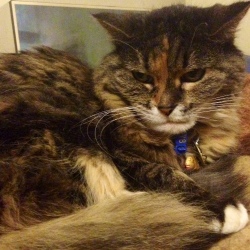Lucy – The Old Feline With A Toothache
Name: Lucy
Species: Feline
Breed: Domestic Long Hair
Sex: Female – Speyed
Age: 15y 8m
Current Weight: 2.9kgs
History: Lucy is a much loved patient here at Wilston Vet. She presented to the clinic to see Dr Kate as her appetite had recently decreased and she seemed to be losing weight. A complete blood profile had been performed earlier in the year and happily her results had been normal, ruling out many of the causes for weight loss and reduced appetite in older felines.
Examination: When Dr Kate examined Lucy’s mouth, it was found that she had a severe feline odontoclastic resorptive lesion (FORL) on her upper left canine tooth, and evidence of calculus and gingivitis on many of her other teeth. FORLs in cats are extremely painful and are caused by intrinsic destruction of the protective enamel coating of the tooth. This exposes the sensitive inner part of the tooth including the nerve and there is often secondary infection and inflammation. FORLs can occur in cats at any age and sadly the only treatment is extraction of the affected tooth.

Treatment: As Lucy had such a nasty tooth lesion, she was scheduled for a major dental procedure the next day. Extreme care is taken with every anaesthetic, especially when performing a procedure on a patient of Lucy’s great age. Happily Lucy’s induction and anaesthesia went very well. Whilst Lucy was asleep, all the calculus was scaled from her teeth and Dr Kate was able to examine her mouth fully. Dr Kate discovered that Lucy had another tooth affected with a FORL.

Dental xrays were taken to determine the extent of the FORLs in Lucy’s mouth:

Note the alveolar bone loss on the xray around the upper left canine tooth with the FORL

Note the tooth on the far right of this xray appears to have been ‘eaten away’ – this is the classic appearance of an FORL on xray.
Both of Lucy’s teeth with the FORLs were extracted surgically. This process uses a periosteal flap (a superficial piece of bone coating taken from the overlying area) which covers the empty socket and is closed with absorbable sutures. The rest of Lucy’s teeth were scaled and polished, and she was administered a long acting antibiotic injection as well as lots of pain relief! She recovered well from her general anaesthetic and went home that night.
Outcome: Lucy returned for a complimentary post dental recheck with Dr Kate two weeks later. Lucy’s owner reported that Lucy had recovered quickly from her major dental procedure, and her appetite had immediately improved! This is what Lucy’s healing tooth socket looked like at this visit:

Vet’s Comment: Feline Ododontoclastic Resorptive Lesions (FORLs) can occur in the teeth of cats of all ages and breeds, and it is estimated that 60% of cats over the age of 6 years will have one or more FORLs. It is thought that FORLs are caused by the re-activation of odontoclasts. Odontoclasts are cells which remove the roots of juvenile teeth as the permanent tooth erupts. Normally the odontoclasts are “turned off” once all the adult teeth have emerged. For some reason, in many adult cats the odontoclasts are re-activated by an unknown stimulus and they start to eat away at healthy adult teeth. This exposes the dentinal tubules and the nerves of the teeth. The tooth becomes extremely painful once the nerve is exposed.
Clinical signs of FORL lesions are:
- pain
- chattering of teeth
- localised gingival hyperplasia
- pink discolouration of the affected tooth
- heavy calculus burden on one side of the mouth
Unfortunately there is no way to prevent FORLs developing, and the only treatment option is extraction of the affected tooth. Regular dental checks and dental scale and polishes under general anaesthetic can help to identify any FORLs which may need to be removed. Cats which have previously had teeth with FORLs extracted must be especially carefully monitored for the development of new FORLs on other apparently healthy teeth.


